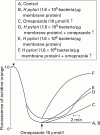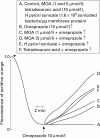Helicobacter pylori augments the acid inhibitory effect of omeprazole on parietal cells and gastric H(+)/K(+)-ATPase
- PMID: 11156634
- PMCID: PMC1728211
- DOI: 10.1136/gut.48.2.157
Helicobacter pylori augments the acid inhibitory effect of omeprazole on parietal cells and gastric H(+)/K(+)-ATPase
Abstract
Background: In duodenal ulcer patients, intragastric acidity during omeprazole treatment is significantly lower before Helicobacter pylori eradication than after cure.
Aims: To determine if H pylori enhances the acid inhibitory potency of omeprazole in isolated parietal cells and on H(+)/K(+)-ATPase.
Methods: Rat parietal cells and pig gastric membrane vesicles enriched in H(+)/K(+)-ATPase activity were incubated with H pylori and the H pylori fatty acid cis 9,10-methyleneoctadecanoic acid (MOA), and the inhibitory effects of omeprazole on parietal cell acid production, H(+)/K(+)-ATPase enzyme activity, and ATPase mediated proton transport were assessed.
Results: In isolated parietal cells, H pylori and MOA increased the acid inhibitory potency of omeprazole 1.8 fold. H pylori did not affect the inhibitory potency of omeprazole on H(+)/K(+)-ATPase enzyme activity. In proton transport studies, H pylori (intact bacteria and sonicate) and MOA accelerated the onset of the inhibitory effect of omeprazole and enhanced the proton dissipation rate in response to omeprazole. H. pylori itself increased proton permeability at the vesicle membrane.
Conclusion: Our results show that H pylori augments the acid inhibitory potency of omeprazole in parietal cells and enhances omeprazole induced proton efflux rate from gastric membrane vesicles. We suggest that omeprazole unmasks the permanent effect of H pylori on proton permeability at the apical parietal cell membrane, which is counteracted in the absence of a proton pump inhibitor by a reserve H(+)/K(+)-ATPase capacity.
Figures






Similar articles
-
Interaction of Helicobacter pylori and its fatty acids with parietal cells and gastric H+/K(+)-ATPase.Gut. 1994 Sep;35(9):1176-80. doi: 10.1136/gut.35.9.1176. Gut. 1994. PMID: 7959221 Free PMC article.
-
Omeprazole, SCH 28080 and doxepin differ in their characteristics to inhibit H+/K+-ATPase driven proton accumulation by parietal cell membrane vesicles.Biochem Pharmacol. 1988 Dec 1;37(23):4487-93. doi: 10.1016/0006-2952(88)90664-8. Biochem Pharmacol. 1988. PMID: 2849447
-
Omeprazole and bafilomycin, two proton pump inhibitors: differentiation of their effects on gastric, kidney and bone H(+)-translocating ATPases.Biochim Biophys Acta. 1991 Jun 18;1065(2):261-8. doi: 10.1016/0005-2736(91)90238-4. Biochim Biophys Acta. 1991. PMID: 1647821
-
The gastric H+,K+-ATPase: the site of action of omeprazole.Scand J Gastroenterol Suppl. 1989;166:3-11. Scand J Gastroenterol Suppl. 1989. PMID: 2557669 Review.
-
Is the sensitivity to gastric acid inhibition Helicobacter pylori status-dependent?Scand J Gastroenterol Suppl. 1998;225:32-5. doi: 10.1080/003655298750027191. Scand J Gastroenterol Suppl. 1998. PMID: 9515750 Review.
Cited by
-
Direct measurement of gastric H+/K+-ATPase activities in patients with or without Helicobacter pylori-associated chronic gastritis.World J Gastroenterol. 2005 Jun 21;11(23):3514-7. doi: 10.3748/wjg.v11.i23.3514. World J Gastroenterol. 2005. PMID: 15962365 Free PMC article.
-
Pathways of Gastric Carcinogenesis, Helicobacter pylori Virulence and Interactions with Antioxidant Systems, Vitamin C and Phytochemicals.Int J Mol Sci. 2020 Sep 3;21(17):6451. doi: 10.3390/ijms21176451. Int J Mol Sci. 2020. PMID: 32899442 Free PMC article. Review.
-
Dynamic functional and ultrastructural changes of gastric parietal cells induced by water immersion-restraint stress in rats.World J Gastroenterol. 2006 Jun 7;12(21):3368-72. doi: 10.3748/wjg.v12.i21.3368. World J Gastroenterol. 2006. PMID: 16733853 Free PMC article.
-
Clinical outcome of patients with Helicobacter pylori infection: the bug, the host, or the environment?Postgrad Med J. 2006 May;82(967):338-42. doi: 10.1136/pgmj.2005.038273. Postgrad Med J. 2006. PMID: 16679473 Free PMC article. Review.
References
Publication types
MeSH terms
Substances
LinkOut - more resources
Full Text Sources
